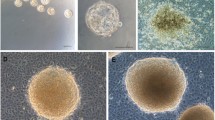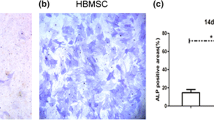Abstract
The amnionic membrane is a rich source of multipotent mesenchymal stromal cells (hAMSC), which are readily available and show a potential use in regenerative medicine and tissue engineering. Before these cells can be applied clinically, careful characterization is necessary, especially as primary cells are known to change their phenotype in culture. We analyzed the mesenchymal phenotype of hAMSC at different stages after isolation using immunohistochemistry. Shortly after isolation (1 day), 92 % (±7 %) of the hAMSC expressed the mesenchymal marker vimentin, 2 % (±1 %) stained for the epithelial marker cytokeratin-7 and 5 % (±4 %) co-expressed these markers. After 5 days, the double positive cells slightly increased to 7 % (±3 %), while exclusive expression of cytokeratin-7 or vimentin remained unchanged (1 % ± 2 % and 92 % ± 1 %, respectively). After the first passage, all attached cells were vimentin-positive, while 54 % (±9 %) co-expressed cytokeratin-7 and vimentin. Thus, we conclude that under culture, hAMSC adopt a hybrid mesenchymal–epithelial phenotype. It is also essential to perform microscopical examination during the first days after isolation to detect contaminations with human amnion-derived epithelial cells in cultures of hAMSC.




Similar content being viewed by others
References
Bilic G, Zeisberger SM, Mallik AS, Zimmermann R, Zisch AH (2008) Comparative characterization of cultured human term amnion epithelial and mesenchymal stromal cells for application in cell therapy. Cell Transpl 17:955–968
Cargnoni A, Gibelli L, Tosini A, Signoroni PB, Nassuato C, Arienti D, Lombardi G, Albertini A, Wengler GS, Parolini O (2009) Transplantation of allogeneic and xenogeneic placenta-derived cells reduces bleomycin-induced lung fibrosis. Cell Transpl 18:405–422
Chaffer CL, Thompson EW, Williams ED (2007) Mesenchymal to epithelial transition in development and disease. Cells Tissues Organs 185(1–3):7–19
Cremer M, Treiss I, Cremer T, Hager D, Franke WW (1981) Characterization of cells of amniotic fluids by immunological identification of intermediate-sized filaments: presence of cells of different tissue origin. Hum Genet 59:373–379
König J, Huppertz B, Desoye G, Parolini O, Fröhlich JD, Weiß G, Dohr G, Sedlmayr P, Lang I (2012) Amnion-derived mesenchymal stromal cells show angiogenic properties but resist differentiation into mature endothelial cells. Stem Cells Dev 21:1309–1320
Parolini O, Alviano F, Bagnara GP, Bilic G, Buhring HJ, Evangelista M, Hennerbichler S, Liu B, Magatti M, Mao N, Miki T, Marongiu F, Nakajima H, Nikaido T, Portmann-Lanz CB, Sankar V, Soncini M, Stadler G, Surbek D, Takahashi TA, Redl H, Sakuragawa N, Wolbank S, Zeisberger S, Zisch A, Strom SC (2008) Concise review: isolation and characterization of cells from human term placenta: outcome of the first international Workshop on placenta derived stem cells. Stem Cells 26:300–311
Pasquinelli G, Tazzari P, Ricci F, Vaselli C, Buzzi M, Conte R, Orrico C, Foroni L, Stella A, Alviano F, Bagnara GP, Lucarelli E (2007) Ultrastructural characteristics of human mesenchymal stromal (stem) cells derived from bone marrow and term placenta. Ultrastruct Pathol 31:23–31
Portmann-Lanz CB, Schoeberlein A, Huber A, Sager R, Malek A, Holzgreve W, Surbek DV (2006) Placental mesenchymal stem cells as potential autologous graft for pre- and perinatal neuroregeneration. Am J Obstet Gynecol 194:664–673
Regauer S, Franke WW, Virtanen I (1985) Intermediate filament cytoskeleton of amnion epithelium and cultured amnion epithelial cells: expression of epidermal cytokeratins in cells of a simple epithelium. J Cell Biol 100:997–1009
Silini A, Parolini O, Huppertz B, Lang I (2013) Soluble factors of amnion-derived cells in treatment of inflammatory and fibrotic pathologies. Curr Stem Cell Res The 8:6–14
Soncini M, Vertua E, Gibelli L, Zorzi F, Denegri M, Albertini A, Wengler GS, Parolini O (2007) Isolation and characterization of mesenchymal cells from human fetal membranes. J Tissue Eng Regen Med 1:296–305
Stadler G, Hennerbichler S, Lindenmair A, Peterbauer A, Hofer K, van Griensven M, Gabriel C, Redl H, Wolbank S (2008) Phenotypic shift of human amniotic epithelial cells in culture is associated with reduced osteogenic differentiation in vitro. Cytotherapy 10:743–752
Tsuji H, Miyoshi S, Ikegami Y, Hida N, Asada H, Togashi I, Suzuki J, Satake M, Nakamizo H, Tanaka M, Mori T, Segawa K, Nishiyama N, Inoue J, Makino H, Miyado K, Ogawa S, Yoshimura Y, Umezawa A (2010) Xenografted human amniotic membrane-derived mesenchymal stem cells are immunologically tolerated and transdifferentiated into cardiomyocytes. Circ Res 106:1613–1623
Acknowledgments
The authors thank the research nurses Bettina Amtmann, Sandra Eppich, and Petra Wagner of the Clinic of Obstetrics and Gynecology for placenta collection, and Kerstin Hingerl and Rudolf Schmied from the Institute of Cell Biology, Histology, and Embryology, Medical University of Graz, Austria, for their valuable technical assistance and expertise. This work was supported by the Franz-Lanyar-Foundation (Projects # 339 and # 349) to I. Lang, J. Fröhlich, and J. König were funded by the Medical University of Graz within the Ph.D. program Molecular Medicine.
Author information
Authors and Affiliations
Corresponding author
Rights and permissions
About this article
Cite this article
König, J., Lang, I., Siwetz, M. et al. Amnion-derived mesenchymal stromal cells show a mesenchymal–epithelial phenotype in culture. Cell Tissue Bank 15, 193–198 (2014). https://doi.org/10.1007/s10561-013-9415-8
Received:
Accepted:
Published:
Issue Date:
DOI: https://doi.org/10.1007/s10561-013-9415-8




